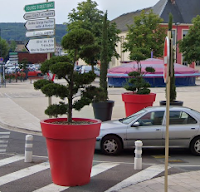If you want to try the Vesoul mystery, the comments after this post link to a YouTube walk around the route. You can no longer do it live on street view. Link to the mystery itself, with scripts and instructions on my tes shop.
In the Google street view mysteries, pupils explore a French town. When they meet people, they have a scripted conversation from which they can extract information and clues. The first two worked so that they could meet the people in any order as they explore, and at the end they had to make a decision to try to save the day.
One took place in a town called Blaru, where at the end they would come across a boy hiding behind some bins, and be able to understand how he had got there and what needed to be done.The other was set in Chateauneuf du Faou, and at the end they had to race to the bridge to stop an accident. This was the suspect's car that they had previously investigated in the town centre, heading for the river! There was also a white van that had been following them around everywhere they went. I remember when they moved to the bridge, turned round and saw the van again, one pupil screamed out loud! Very similar in that respect to when the pupils eventually tracked down the villain in the Workhouse. (Scary life size mannequin mystery.)
And of course, one day, Google sent the car to take new photos, and the mysteries were over. (Although you can use the go back in time feature, so I could re-create them.)
During lockdown I had time to do another. This time set in Vesoul. A town apparently under attack from plants! Too much time! It's a monster. The video has a tutorial on how to use it. And the mystery is available to download here.
In lockdown a few keen Year 10s completed it (and one dedicated Year 7 pupil). I am now trying it with my Year 8. It has taken us two lessons in the computer room so far, and we are about half way. We didn't spend the whole lesson on it - I didn't want them to get fed up of it, and so I started and ended the lesson with other activities. I was wondering whether to continue in the normal classroom and do it on the whiteboard. That way we could encounter a couple of characters at the start or end of a lesson, and make the mystery last half a term. Given they way they worked today, though, I think I will be booking the computer room again, and I think it is important for them to have those "scream out loud" moments for themselves.
Advice for teachers wanting to try it: It has definitely emerged that the teacher has to be very familiar with the route. In the Vesoul one, there are clear instructions given in English (in the booklet) and in French (by the characters) as to where to go next. But a wrong turn takes you off on a wild goose chase. I have inserted "checkpoints" (links to the correct street in google street view) for any pupils who do get lost. And check in the comments below for another solution to this.
It's also good to be able to keep their interest by building up some of the characters and places,"L'homme nu," "The talking cat," "the homeless dog," "the houses destroyed by plants." It is also good to let them find some things for themselves - the street of umbrellas, the balcony of disappearing plants, the microwave thrown out of the window, the cat food... No-one has screamed yet with this one, but they will!The conversations are all in French, but with questions in English. The questions "feed" pupils the words they are not likely to know, so by reading the questions, they can understand what they are being told. Certainly my Year 8s were so bound up in the story, that they didn't comment at all about the fact that it was all in French. They just got on with answering the
questions and finding out more clues.
There is also sound for each conversation, recorded specially by volunteers from the #mfltwitterati. I got their recordings using Qwiqr conversations, as suggested by @ivana_stanley on twitter. Some of my Year 8s are listening to them, others are concentrating on navegating and reading. If I do some on the board in the normal classroom, I think I will make use of the sound then.
Please do have a good look at it and think about using it with your classes - in the computer room, as a homework project, or in lessons in installments. The old original ones were very popular and very well-used. We need to get as much use out of it as possible before Google get round to re-doing the photos!
As predicted, part of the route has been re-photographed by Google. Look in the comments below for links to screenshot videos of the correct route if you want to keep using the Mystery!






If you are worried that pupils will keep getting lost on Street View and you don't know the route well enough to spot when this happens, then I have made a video of the route. If your pupils can access YouTube, they can follow the route on the video instead of doing street view. Or you could use it to reconnoitre the route.
ReplyDeletePart 1 https://youtu.be/LsssUnKTdSA
Part 2 https://youtu.be/PACa3nSFUxE
Now that Google have redone the photos, the way to do this is to use the videos of the route in the comment above. Pupils should pause when they spot the character they are looking for and read the conversation and pick up the clues.
ReplyDelete